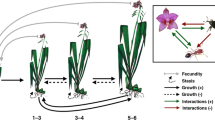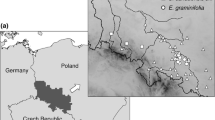Abstract
Although the ecology of many exotic invaders has been intensively examined in the novel range, few studies have comparatively explored how population dynamics differ in native and novel parts of an invading plants’ range. The population dynamics of mile-a-minute weed, Polygonum perfoliatum L., was explored in both the native (Japan) and novel (northeastern USA) portions of its range and evaluated using periodic matrix models. Projected per capita population growth rate (λ) varied within and between native and novel range populations. Surprisingly, five of the six populations in the novel range were projected to fail to replace themselves (λ<1) while only two of the four native range populations were projected to decline, although these projections had wider confidence intervals than in the novel habitat. While changes in germination, survivorship, fecundity and seed banking would have equivalent effects on population growth in the invasive habitat, small increases in plant survivorship would greatly increase λ in native populations. The differences between native and novel population growth rates were driven by lower adult survival in the native range caused by annual flooding and higher fecundity. Simulation analyses indicated that a 50% reduction in plant survival would be required to control growing populations in the novel range. Further comparative studies of other invading species in both their native and novel ranges are needed to examine whether the high per capita population growth and strong regulatory effects of adult survival in the native habitat are generally predictive of invasive behavior in novel habitats.
Similar content being viewed by others
References
PO Ang RE DeWreede (1993) ArticleTitleSimulation and analysis of the dynamics of a Fucus distichus (Phaeophyceae, Fucales) population Marine Ecology Progress Series 93 253–265
HG Baker (1965) Characteristics and modes of the origin of weeds HG Baker GL Stebbins (Eds) The Genetics of Colonizing Species Academic Press New York 147–168
H Caswell (1978) ArticleTitleA general formula for the sensitivity of population growth rate to changes in life history parameters Theoretical Population Biology 14 215–230 Occurrence Handle371054 Occurrence Handle10.1016/0040-5809(78)90025-4 Occurrence Handle1:STN:280:CSaC3sbltl0%3D
H Caswell (1989) ArticleTitleAnalysis of life table response experiments. I. Decomposition of effects on population growth rate Ecological Modeling 46 221–237 Occurrence Handle10.1016/0304-3800(89)90019-7 Occurrence Handle1:CAS:528:DyaL1MXmt1Klt78%3D
H Caswell (2001) Matrix Population Models EditionNumber2 Sinauer Press Sunderland, MA
H Caswell MC Trevisan (1994) ArticleTitleSensitivity analysis of periodic matrix models Ecology 75 1299–1303
ME Cochran S Ellner (1992) ArticleTitleSimple methods for calculating age-based life-history parameters for stage-structured populations Ecological Monographs 62 345–364
MJ Crawley (1989) ArticleTitleInsect herbivores and plant population dynamics Annual Reviews of Entomology 34 531–564 Occurrence Handle10.1146/annurev.en.34.010189.002531
de Kroon H, Plaisier A, van Groenendael J and Caswell H (1986) Elasticity: the relative contribution of demographic parameters to population growth rate. Ecology 67
B Efron RJ Tibshirani (1993) An Introduction to the Bootstrap Chapman and Hall New York
HA Gleason A Cronquist (1998) Manual of Vascular Plants of Northeastern United States and Adjacent Canada EditionNumber2 The New York Botanical Garden New York
K Grigulis AW Sheppard JE Ash RH Groves (2001) ArticleTitleThe comparative demography of the pasture weed Echium plantagineum between its native and invaded ranges Journal of Applied Ecology 38 281–290 Occurrence Handle10.1046/j.1365-2664.2001.00587.x
JP Grime (2001) Plant Strategies, Vegetation Processes, and Ecosystem Properties John Wiley & Sons Inc. New York
Hickman JC and Hickman CS (1977) Polygonum perfoliatum: a recent Asiatic adventive Bartonia. 45: 18–23
CC Horvitz DW Schemske (1995) ArticleTitleSpatiotemporal variation in demographic transitions of a tropical understory herb: projection matrix analysis Ecological Monographs 65 155–192
LF Huenneke PL Marks (1987) ArticleTitleStem dynamics of the shrub Alnus incana ssp. rugosa: transition matrix models Ecology 68 1234–1242
LA Hyatt (1998) ArticleTitleSpatial patterns and causes of overwinter seed mortality in Phytolacca americana Canadian Journal of Botany 76 197–203 Occurrence Handle10.1139/cjb-76-2-197
S Kalisz MA McPeek (1992) ArticleTitleDemography of an age-structured annual: resampled projection matrices, elasticity analyses and seed bank effects Ecology 73 1082–1093
D Kriticos J Brown I Radford M Nicholas (1999) ArticleTitlePlant population ecology and biological control: Acacia nilotica as a case study Biological Control 16 230–239 Occurrence Handle10.1006/bcon.1999.0746
RM Mack D Simberloff WM Lonsdale H Evans M Clout FA Bazzaz (2000) ArticleTitleBiotic invasions: causes, epidemiology, global consequences, and control Ecological Applications 10 689–710
MC Mandujano C Montana M Franco J Golubov A Flores-Martinez (2001) ArticleTitleIntegration of demographic annual variability in a clonal desert cactus Ecology 82 344–359
MS McClure (1986) ArticleTitlePopulation dynamics of Japanese hemlock scales: a comparison of endemic and exotic communities Ecology 67 1411–1421
PB McEvoy EM Coombs (1999) ArticleTitleBiological control of plant invaders: regional patterns, field experiments, and structured population models Ecological Applications 9 387–401
MA McPeek S Kalisz (1993) Population sampling and bootstrapping in complex designs: demographic analysis SM Scheiner J Gurevitch (Eds) Design and Analysis of Ecological Experiments Chapman & Hall New York 232–252
ES Menges (1990) ArticleTitlePopulation viability analysis for an endangered plant Conservation Biology 4 52–62 Occurrence Handle10.1111/j.1523-1739.1990.tb00267.x
ET Moul (1948) ArticleTitleA dangerous weedy Polygonum in Pennsylvania Rhodora 50 64–66
WL Mountain (1989) ArticleTitleMile-a-minute (Polygonum perfoliatum L.) update – distribution, biology and control suggestions Regulatory Horticulture Weed Circular 15 21–24
Mountain WL (1995) Mile-a-minute – History, Distribution, and Habitat. Mile-a-minute (Polygonum perfoliatum) Conference. York, Pennsylvania, July
National Invasive Species Council (2001) National Management Plan: Meeting the Invasive Species Challenge. Washington, DC
J Ohwi (1965) Polygonum perfoliatum L FG Meyer EH Walker (Eds) Flora of Japan. Smithsonian Institution Washington, DC 1607
JA Okay (1997) Polygonum perfoliatum: A Study of Biological and Ecological Features Leading to the Formation of a Management Policy George Mason University Fairfax VA
IM Parker (2000) ArticleTitleInvasion dynamics of Cytisus scoparius: a matrix model approach Ecological Applications 10 726–743
M Rejmánek DM Richardson (1996) ArticleTitleWhat attributes make some plant species more invasive? Ecology 77 1655–1661
DW Schemske BC Husband MH Ruckelshaus C Goodwillie IM Parker J Bishop (1995) ArticleTitleEvaluating approaches to the conservation of rare and endangered plants Ecology 75 584–606
AA Sher LA Hyatt (1999) ArticleTitleThe disturbed resource-flux invasion matrix: a new framework for patterns of plant invasion Biological Invasions 1 107–114 Occurrence Handle10.1023/A:1010050420466
J Silvertown M Franco I Pisanty A Mendoza (1993) ArticleTitleComparative plant demography – relative importance of life-cycle components to the finite rate of increase in woody and herbaceous perennials Journal of Ecology 81 465–476
D Simberloff P Stiling (1996) ArticleTitleHow risky is biological control? Ecology 77 1965–1974
Skellam JG (1966) Seasonal periodicity in theoretical population ecology. Paper read at Proceedings of the 5th Berkeley Symposium on Mathematical Statistics and Probability
H Sukopp U Starfinger (1995) Reynoutria sachalinensis in Europe and in the Far East: a comparison of the species ecology in its native and adventive distribution ranges P Pysek K Prach M Rejmánek M Wade (Eds) Plant Invasions – General Aspects and Special Problems. SBP Academic Amsterdam 151–159
PA Werner J Caswell (1977) ArticleTitlePopulation growth rates and age versus stage-distribution models for teasel (Dipsacus sylvestris Huds.) Ecology 58 1103–1111
Author information
Authors and Affiliations
Corresponding author
Additional information
Sachiko Araki: (Deceased)
Rights and permissions
About this article
Cite this article
Hyatt, L.A., Araki, S. Comparative Population Dynamics of an Invading Species in its Native and Novel Ranges. Biol Invasions 8, 261–275 (2006). https://doi.org/10.1007/s10530-004-5572-9
Received:
Accepted:
Issue Date:
DOI: https://doi.org/10.1007/s10530-004-5572-9




